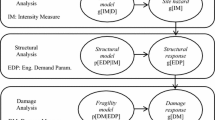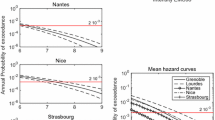Abstract
There are two fundamental questions this article aims to deal with. First, whether a pre-earthquake strengthening of a large and heterogeneous building stock (the emphasis here is on building types common in S. Europe), is economically feasible or not, and second what is the optimal retrofit level for mitigating the seismic risk. To this purpose contemporary decision making tools, namely cost-benefit and life-cycle cost analyses, are tailored to the needs of the present study, and implemented with the aid of an ad-hoc developed new software application (COBE06). A method for estimating the reduction in structural vulnerability due to retrofit is proposed, as well as a methodology to determine the optimum retrofit level using the fragility curve approach. Finally, the proposed methodology is used in a pilot application that concerns the city of Thessaloniki, and results are drawn for the feasibility of strengthening the reinforced concrete building stock in this city.













Similar content being viewed by others
Abbreviations
- CDI,k :
-
Central damage index (of kth damage state)
- DPM:
-
Damage probability matrix
- DS:
-
Damage state
- ESYE:
-
Statistics agency of Greece
- FEMA:
-
Federal emergency management agency (USA)
- FRP:
-
Fiber reinforced polymers
- I MM :
-
Modified mercalli intensity
- D mv :
-
Mean damage factor
- PGA:
-
Peak ground acceleration
- R/C:
-
Reinforced concrete
- R L :
-
Retrofit level
- SVHL:
-
Statistical value of human life
References
Alesch DJ, Dargush GF, Mircea G, William PJ, von Winterfeldt D (2003) Decision models: approaches for achieving seismic resilience, In: Selection of papers chronicling technical achievements of the Multidisciplinary Center for Earthquake Engineering Research (Ed, 2001–2003, R. P. a. A.) MCEER
ATC-13 (1985). Earthquake damage evaluation data for California, Applied Technology Council, Redwood City, CA
Coburn A, Spence R (2002) Earthquake protection, 2nd edn. Wiley, Chichester, England
Comerio MC (1992) Impacts of the Los Angeles retrofit ordinance on residential buildings. Earthq Spectra 8(1):79–94
Ellingwood BR, Wen YK (2005) Risk-benefit-based design decisions for low-probability/high consequence earthquake events in Mid-America. Prog Struct Eng Mater 7:56–70
ESYE (Statistics Agency of Greece) (2005) Website (http://www.statistics.gr)
FEMA (Federal Emergency Management Agency) (1992) A benefit/cost model for the seismic rehabilitation of buildings (FEMA 227), Vols 1, 2. VSP Associates, Sacramento, California
Ferrito J (1997) Economic analysis procedure for earthquake hazard mitigation. Naval Facilities Engineering Service Center, California
Frangopol DM, Kong JS, Gharaibeh ES (2001) Reliability-based life-cycle management of highway bridges. J Comput Civ Eng 15
Grossi P (2000) Earthquake damage assessment: from expert opinion to fragility curves. In: 8th ASCE specialty conference on probabilistic mechanics and structural reliability
Kappos AJ et al (2004a) Vulnerability assessment of current buildings, Chap 4. In: Synthesis of the application to Thessaloniki city, RISK-UE Report (Contract: EVK4-CT-2000-00014)
Kappos A, Pitilakis K, Stylianidis K, Morfidis K, Asimakopoulos D (1995) Cost-benefit analysis for the seismic rehabilitation of buildings in Thessaloniki based on a hybrid method of vulnerability assessment. In: 3rd International Conference on seismic zonation, Vol I. Nice, France, pp 406–413
Kappos AJ, Panagopoulos G, Panagiotopoulos C, Penelis G (2006) A hybrid method for the vulnerability assessment of R/C and URM buildings. Bull Earthq Eng 4(4): 391–413
Kappos AJ, Panagiotopoulos C, Panagopoulos G (2004b) Derivation of fragility curves using inelastic time-history analysis and damage statistics. CD ROM Proceedings ICCES’04, Madeira, Portugal, July 2004. pp 665–672
Kappos AJ, Stylianidis KC, Pitilakis K (1998) Development of seismic risk scenarios based on a hybrid method of vulnerability assessment. Nat Hazards 17(2):177–192
Koliopoulos PK, Margaris BN, Klimis NS (1998) Duration and energy characteristics of Greek strong motion records. J Earthq Eng 2(3):391–417
Liu M, Burns SA, Wen YK (2003) Optimal seismic design of steel frame buildings based on life-cycle cost considerations. Earthq Eng Struct Dyn 32:1313–1332 (http://dx.doi.org.10.1002/eqe.273)
Nuti C, Vanzi I (2002) Optimization of seismic retrofitting the case study of a hospital in Italy. In: 12th European conference on earthquake engineering, Elsevier Science Ltd., London
Papaioannou CΑ (2004) Seismic hazard scenarios—probabilistic assessment of the seismic hazard report for WP 02 of the project SRM-LIFE (Scientist in charge Κ. Pitilakis), ΙΤSΑΚ, Thessaloniki (in Greek)
Papazachos B, Papazachou C (1997) The Earthquakes of Greece. Ziti Editions, Thessaloniki
Papazachos BC, Savaidis AA, Papaioannou ChA, Papazachos CB (1999) The S. Balkan Bank of shallow and intermediate depth earthquake macroseismic data. XXII Gen. Ass. of the IUGG, Birmingham, UK, July 1999 (abstracts volume)
Penelis GG, Kappos AJ (1997) Earthquake-resistant concrete structures. E & FN SPON (Chapman & Hall), London
Penelis GG, Sarigiannis D, Stavrakakis E, Stylianidis KC (1989) A statistical evaluation of damage to buildings in the Thessaloniki, Greece, earthquake of June, 20, 1978. In: Proceedings of 9th world conference on earthquake engineering (Tokyo-Kyoto, Japan), Tokyo, Maruzen VII:187–192
Shinozuka M, Grigoriu M, Ingraffea AR, Billington SL, Feenstra P, Soong TT, Reinhorn AM, Maragakis E (2000) Development of fragility information for structures and nonstructural components, MCCER2000
Smyth AW, Altay GI, Deodatis G, Erdik M, Franco G, Gulkan P, Kunreuther H, Lus H, Mete E, Seeber N, Yuzugullu O (2004) Probabilistic benefit/cost analysis for earthquake damage mitigation: evaluating measures for apartment houses in Turkey. Earthq Spectra 20(1):171–203
Takahashi Y, Kiureghian A, Ang AHS (2004) Life-cycle cost analysis based on a renewal model of earthquake occurrences. Earthq Eng Struct Dyn 33:859–880
Vacareanu R, Lungu D, Aldea A, Arion C (2004) WP7 report seismic risk scenarios handbook. In: RISK-UE an advanced approach to earthquake risk scenarios with applications to different European towns
Wen YK, Kang YJ (2001) Minimum building life-cycle cost design criteria. I: methodology. J Struct Eng, ASCE 127(3)
Zerbe RO, Falit-Baiamonte A (2001) The use of benefit/cost analysis for evaluation of performance-based earthquake engineering decisions, PEER rep. 2002/06, September 2001
Acknowledgements
Large part of the work presented herein was carried out within the framework of the research programme ARISTION (“Seismic vulnerability assessment of existing buildings and development of advanced materials and strengthening techniques”) funded by the General Secretariat for Research of the Greek Government. The writers would also like to acknowledge the contribution of Mr I. Vlachos (member of the ARISTION research group) for providing data to the present study, as well as suggestions based on his experience with building insurance.
Author information
Authors and Affiliations
Corresponding author
Rights and permissions
About this article
Cite this article
Kappos, A.J., Dimitrakopoulos, E.G. Feasibility of pre-earthquake strengthening of buildings based on cost-benefit and life-cycle cost analysis, with the aid of fragility curves. Nat Hazards 45, 33–54 (2008). https://doi.org/10.1007/s11069-007-9155-9
Received:
Accepted:
Published:
Issue Date:
DOI: https://doi.org/10.1007/s11069-007-9155-9




